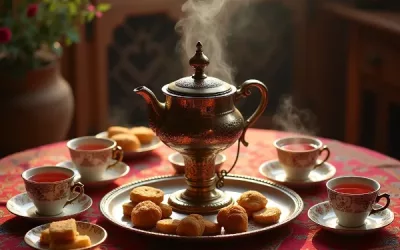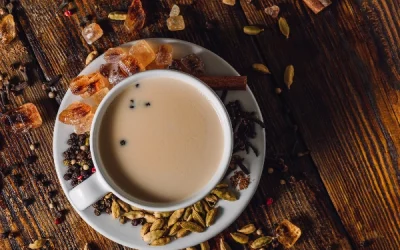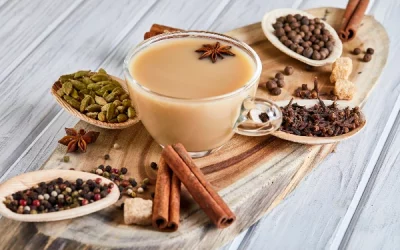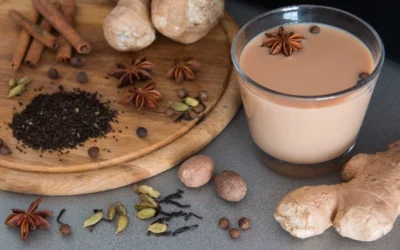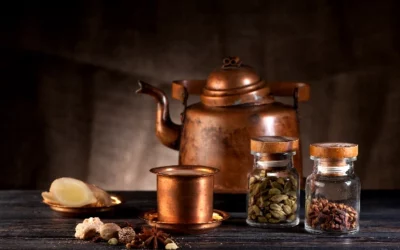Have you ever savoured a cup of masala chai and wondered about its rich history? This traditional Indian beverage, blending spices, tea, and milk, has woven itself into the cultural fabric of India and beyond. In this article, we’ll explore the origins and rituals surrounding masala chai, its health benefits, and how you can recreate this aromatic delight at home. By mastering the art of making authentic masala chai tea, not only will you indulge your taste buds, but you’ll also connect with a cherished culinary tradition.
Table of Content
- What is Masala Chai Tea?
- What are the key ingredients in Masala Chai Tea?
- How to prepare Masala Chai Tea step-by-step?
- What are the health benefits of masala chai tea?
- How can you customise masala chai tea to suit your taste?
- What are some common mistakes to avoid when making Masala Chai Tea?
- How can you store and serve Masala Chai Tea?
- What are the regional variations of masala chai tea?
- Conclusion
What is Masala Chai Tea?
Masala chai tea is a spicy-sweet, milky beverage that originates from India. The term “masala” translates to “spice mixture,” and “chai” means “tea” in Hindi. Combining a blend of spices, black tea, milk, and sweeteners, masala chai is a staple in Indian households and street shops.
Masala chai tea holds deep cultural importance in India. Its history dates back thousands of years, with roots in traditional Ayurvedic medicine. Each region in India boasts its unique blend, but the core elements remain consistent. The tea has gained worldwide popularity for its rich flavour profile and its warming, comforting effects.
What are the origins of masala chai tea?
Masala chai tea dates back nearly 5,000 years. Initially, it was an Ayurvedic healing drink. Merchants in the spice trade spread the beverage’s popularity. The British influence in India during the colonial period further integrated black tea into the recipe. By the early 20th century, masala chai became an everyday choice among Indians.
- Dates back to 5,000 years
- Initially used for Ayurveda
- Spread through spice trade
- Incorporated black tea during British colonial rule
- Became an everyday drink by 20th century
How is masala chai tea traditionally prepared?
Traditional masala chai tea involves boiling water with a mix of spices like cardamom, cinnamon, ginger, and cloves. Black tea leaves, milk, and sugar are then added. The mixture is boiled again to blend flavours before straining into cups.
- Boil water with spices like cardamom, ginger, and cloves
- Add black tea leaves, milk, and sugar
- Boil again to blend flavours
- Strain into cups before serving
The preparation captures all the rich spices and aromas that make masala chai so comforting and beloved.
Why is masala chai tea culturally significant in India?
Masala chai tea is more than just a beverage in India. It’s a social glue that brings people together. From roadside stalls to family gatherings, sharing a cup of chai is an everyday practice. It’s often offered as a sign of hospitality to guests. The tea has become an icon of Indian culture, weaving through the daily lives of millions.
- Common in family gatherings and social interactions
- Served at roadside stalls and luxurious homes alike
- Symbol of Indian hospitality and culture
- Integral part of daily routine for many Indians
- Represents warmth and togetherness
Globally, masala chai has become synonymous with Indian culture, and it’s widely appreciated for its unique blend of exciting flavours.
Chaiwallahs, or tea sellers, are integral to Indian society. Streets bustling with the sounds of tea being poured, the inviting aroma of spices, and people engaging in lively conversations around a steaming cup of chai are common sights. Chaiwallahs have achieved a cultural status and are indispensable to India’s fabric.
What are the key ingredients in Masala Chai Tea?
Masala chai tea is a vibrant, aromatic beverage hailing from India, combining black tea with a medley of spices, milk, and sweetener. Each ingredient plays a unique role in crafting this comforting and invigorating drink. Knowing the essentials and potential substitutes allows you to customise your brew while maintaining its traditional essence.
Below is a table that outlines the key ingredients in masala chai tea, their roles, and possible substitutions. This table will help you understand the significance of each component and how to adapt the recipe if certain items are unavailable.
| Ingredient | Role in Tea | Potential Substitutions |
|---|---|---|
| Black Tea | Base flavour and caffeine source | Assam, Darjeeling, Ceylon tea |
| Ginger | Adds warmth and a spicy kick | Dried ginger powder |
| Cardamom Pods | Imparts a sweet, floral aroma | Ground cardamom |
| Cinnamon Sticks | Offers a sweet, woody, and spicy flavour | Ground cinnamon |
| Cloves | Adds a strong, earthy, and slightly bitter taste | Ground cloves |
| Black Peppercorns | Contributes a sharp, pungent heat | Ground black pepper |
| Milk | Creates a creamy and rich texture | Dairy alternatives (soy, almond) |
| Sweetener (sugar/honey) | Enhances the overall sweetness and balances spices | Maple syrup, agave nectar |
This table ensures a comprehensive understanding of the traditional masala chai tea ingredients and how you might adjust them to suit your pantry’s contents.
How to make traditional masala chai tea?
Making masala chai at home is simpler than you might think. It starts with simmering spices and tea to extract their flavours before adding milk and sweetener. The process is brief yet gratifying, filling your kitchen with a tantalising aroma.
To get started, gather your ingredients and follow these steps:
- Boil 2 cups of water in a pot.
- Add ginger, cardamom pods, cinnamon sticks, cloves, and black peppercorns.
- Boil the mix for 5-10 minutes until you achieve a strong aroma.
- Add 2 tablespoons of black tea leaves and let it steep for 3-5 minutes.
- Pour in 1 cup of milk and sweeten to taste.
- Bring to a boil again, then strain the tea into cups.
By following these steps, you can enjoy a fresh cup of homemade masala chai.
Benefits of drinking masala chai tea
Masala chai provides more than just a delicious experience. It hosts numerous health benefits from its rich blend of spices and tea, making it a delightful yet nutritious drink.
- Boosts Immunity: Spices like ginger and cardamom can help strengthen your immune system.
- Improves Digestion: Masala chai aids digestion, thanks to its combination of ginger, clove, and black tea.
- Reduces Inflammation: Ingredients like cinnamon and cloves have anti-inflammatory properties.
- Regulates Metabolism: The blend of spices can help in regulating and boosting your metabolism.
- Caffeine Kick: The black tea provides a healthy dose of caffeine to boost your energy levels.
These benefits make masala chai a fantastic option for those who want a delicious, health-boosting beverage.
Tips for customising your chai
Personalising your masala chai allows you to tailor it to your taste preferences, dietary restrictions, or available ingredients. Variations can be simple yet profoundly affect your chai experience.
- Adjust Spice Levels: Modify the quantities of spices according to your flavour preference.
- Use Dairy Alternatives: Opt for almond, soy, or oat milk instead of traditional dairy.
- Sweetness Control: Choose natural sweeteners like honey or agave nectar for a healthier option.
- Tea Strength: Increase or decrease the amount of black tea to change the strength of your brew.
- Additional Flavours: Experiment with adding star anise, nutmeg, or vanilla for a different twist.
Feel free to experiment with these variations to find your perfect cup of masala chai tea.
During the mid-19th century, the British East India Company established large tea plantations in Assam, India. To promote tea consumption in India, they initially distributed free samples. Over time, the locals adapted the British tea with traditional Indian spices, giving birth to what we now know as masala chai. This spicy twist captivated the palates of many and became a staple in Indian households and street stalls.
I remember the first time I tried making masala chai at home. Craving the rich, spiced aroma reminiscent of the streets of Mumbai, I decided to give it a go. The whole kitchen became filled with the fragrances of ginger and cardamom.
Each sip took me back to my favourite chai vendor, and the homemade version surprisingly matched up to the street classic. Nothing beats enjoying a warm cup of masala chai, especially on a chilly day.
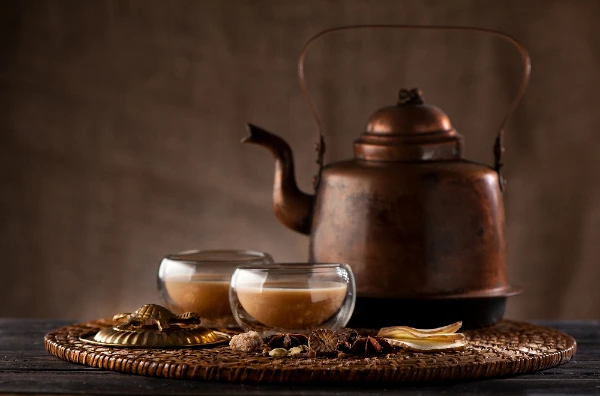
How to prepare Masala Chai Tea step-by-step?
Alright, mate, so you fancy making some proper masala chai tea at home, do you? Good choice! This isn’t just any cup of tea; it’s an aromatic adventure. Let’s dive into the world of spice and everything nice.
First, we need to get the basics right. Start with fresh ingredients because nobody likes stale tea leaves and bland spices. Let’s break down the process into simple, easy-to-digest steps. Think of it like assembling IKEA furniture but without the cryptic diagrams.
What are the steps to brew the perfect masala chai tea?
Here’s how you brew perfection in a cup:
- Water First: Boil some water. You need about one cup per serving. This is the base, the blank canvas for your masterpiece.
- Add Tea Leaves: Throw in some loose black tea leaves—about one teaspoon per cup. If you’re lazy (not judging), tea bags will do the trick, but loose leaves are better.
- Spice it Up: Add your spices. We’re talking cardamom pods, cloves, a stick of cinnamon, a dash of black pepper, and a bit of ginger. Crush them slightly to release the flavours.
- Simmer Down: Once the water hits the boiling point, reduce the heat and let it simmer. This helps the spices blend in nicely.
- Milk Magic: Pour in some milk. Full fat if you want it creamy, but any milk will do. You want the ratio to be about 1:1 for water and milk.
- Sweeten the Deal: Add sugar to taste. Brown sugar or even honey works well here, depending on your sweet tooth.
- Boil Again: Let the mixture come to a gentle boil, stirring occasionally to make sure everything marries well.
- Strain and Serve: Use a fine mesh strainer to pour the tea into your favourite mug. Enjoy immediately, because who wants lukewarm tea?
Now, you’re ready to make a cup of masala chai tea that’ll knock your socks off.
How do you ensure the spices are well-balanced?
This isn’t rocket science, but it’s crucial to get the balance right. Here’s how you can avoid ending up with spice soup:
- Start Simple: Begin with a couple of cardamom pods, a small cinnamon stick, a few cloves, a pinch of pepper, and a small piece of ginger. Adjust to taste as you get more comfortable.
- Crush Lightly: Gently crush the spices to release their essential oils. Too much force, and you will overdo it. Remember, you’re making tea, not curry.
- Heat Matters: Spices release their flavours in hot water. Start by adding the spices before boiling and let them simmer gently.
- Taste Test: Before you add milk and sugar, taste to check the spice level. It’s easier to fix now rather than after you’ve added the milk.
Getting your spices just right involves a bit of trial and error, but remember, even if it’s not perfect, it’s still delicious.
What is the ideal simmering time for masala chai tea?
Ah, the simmering time. This is where patience is key.
- Initial Simmer: After adding tea leaves and spices to boiling water, let it simmer for 5 minutes. This allows the full depth of the spices and tea leaves to infuse the water.
- After Adding Milk: Once the milk is added, bring the mixture to a gentle boil and then let it simmer for another 5-10 minutes. Stir occasionally to prevent the milk from burning and ensure the spices distribute evenly.
- Watch Closely: Your tea should take on a rich, golden-brown colour. If it looks too pale or too dark, adjust your simmering time accordingly.
Simmering allows all the flavours to meld together. Patience here means a more potent and flavourful chai.
In the realms of Indian history, there’s an interesting tidbit about the origin of masala chai. Legend has it that Indian royalty first conceived the idea during the early centuries, seeking a drink that combined medicinal spices with the pleasure of tea. They must have had good taste because masala chai has cemented itself as an iconic symbol of India’s gastronomical culture.
So, there you have it! Making masala chai tea is part science, part art, and all delicious. Happy brewing, and enjoy every spicy, milky sip!
What are the health benefits of masala chai tea?
Let’s dive into the world of masala chai tea, where the concoction is not just a feast for your taste buds but also a blessing for your body. This traditional Indian drink is packed with health benefits that range from aiding digestion to boosting immunity. So, let’s spill the tea on why you should pour yourself another cup of this delightful brew.
How does masala chai tea aid in digestion?
The magic of masala chai tea lies in its unique combination of spices. Ginger and black pepper are the unsung heroes that work wonders for your digestive system:
- Ginger: This root is nature’s remedy for stomach discomfort. It increases saliva and bile production, which means your food gets broken down more effectively.
- Black pepper: It contains piperine, which stimulates the stomach to produce more hydrochloric acid. This helps in breaking down food faster.
- Cardamom: It’s not just a pretty face; cardamom is a traditional remedy for bloating and gas.
- Cinnamon: Apart from adding warmth to your cup, cinnamon helps regulate blood sugar levels, reducing the chances of digestive issues.
These spices are like a mini army fighting off digestive woes and making sure your stomach stays happy.
What anti-inflammatory benefits does masala chai tea offer?
Ever heard your joints creak like an old door in a horror film? Masala chai tea can help you with that. Its anti-inflammatory properties come from a trio of superhero spices:
- Ginger: Once again, ginger steps up. Its main compound, gingerol, has potent anti-inflammatory effects.
- Cinnamon: It’s not just tasty; cinnamon is rich in antioxidants that reduce inflammation.
- Cloves: These little guys are packed with eugenol, known for its anti-inflammatory and analgesic properties.
- Black pepper: Who knew piperine could help reduce inflammation? Now you do.
Together, these spices form a formidable squad against inflammation, making your joints and muscles thank you endlessly.
How does masala chai tea boost the immune system?
Feeling under the weather? Time to brew a steaming cup of masala chai. The ingredients in this tea literally make your immune system do a happy dance:
- Cardamom: This spice is full of antioxidants that battle oxidative stress and boost your overall health.
- Cloves: Their antiviral and antibacterial properties help fend off nasty infections.
- Cinnamon: Again, the antioxidants in cinnamon help fight off ailments.
- Ginger: Rich in antioxidants, ginger also has anti-viral properties, making it your go-to when you feel a cold coming on.
These spices give your immune system the strength of a gladiator, ready to battle all those annoying bugs and viruses.
Stress Relief and Antioxidant Properties
Let’s add another feather to masala chai’s cap. This tea isn’t just functional; it’s also wonderfully relaxing. The black tea base provides a moderate amount of caffeine, which can be a great pick-me-up without causing the jitters. Plus:
- Cinnamon and cloves: These help in stress reduction.
- Ginger: Known for its calming properties, which can help alleviate stress.
The blend of spices in masala chai also offers a hefty dose of antioxidants. These compounds neutralise harmful free radicals in your body, which can cause chronic diseases and accelerate ageing.
And now, for a little historical flavour, let’s travel back in time. In 1942, during World War II, the British Indian Army introduced masala chai to soldiers as a means to keep them alert and hydrated.
The blend of spices not only gave them energy but also kept many health issues at bay, making it a staple in military camps and eventually spreading to civilian life. So, when you sip on your cup of masala chai, you are not only enjoying a delicious brew but also a piece of history!
How can you customise masala chai tea to suit your taste?
Oh, masala chai tea! That aromatic, spicy elixir from India that just seems to make everything better, right? Now, wouldn’t you love to tailor this magical brew to your very own taste? You’re in luck because adjusting masala chai to suit your preferences is as easy as pie, err, tea? Let’s dive into the nitty-gritty details of turning this classic into your personal masterpiece.
Adjusting spice levels
Are you someone who likes to live on the edge with extra spice, or do you prefer to keep things mellow and mild? Adjusting the spice levels in your masala chai tea recipe is the most straightforward way to make it your own.
- More spices: Add extra ginger, cloves, or black pepper if you love a spicy kick.
- Less spices: Dial back on the stronger spices like cardamom and cloves for a more subtle flavour.
- Balance: Stick to the traditional mix of cinnamon, ginger, cardamom, black pepper, and cloves but play around with the quantities to find your perfect balance.
- Experiment: Add a pinch of nutmeg or star anise to jazz things up.
- Freshness: Use freshly ground spices for an intense, aromatic experience.
Whether you lean towards fire-breathing dragon levels of spice or something resembling a gentle kiss from a butterfly, you can control it all with your spice rack.
Alternatives to cow’s milk
Not a fan of cow’s milk? Lactose intolerant? Vegan? No worries, because this customisation is a walk in the park. There are so many substitutes to choose from, you might just change your mind about cow’s milk altogether.
- Almond milk: Light and nutty, and doesn’t overpower the spices.
- Coconut milk: Adds a creamy, tropical twist to your tea.
- Soy milk: A bit thicker and offers a slightly different texture.
- Oat milk: Creamy and slightly sweet, perfect for masala chai.
- Rice milk: Thinner and a bit sweet, it works well if you want a lighter version.
You get the point—there’s a dairy-free solution for everyone. Just swap out the cow’s milk and continue brewing!
Caffeine-free version
Sometimes, you want the flavour without the wake-up call. Making a caffeine-free version of masala chai tea is as easy as flipping a switch.
- Herbal teas: Swap out black tea for herbal teas like rooibos or chamomile.
- Decaffeinated black tea: Get the traditional taste without the buzz.
- More spices, less tea: Increase the spice blend and decrease the amount of tea leaves.
- Caffeine-free tea bags: Just grab a pack of decaf tea bags from your local store.
With these alternatives, you can enjoy your masala chai at any hour. Sweet dreams are made of these.
One fun fact: Did you know that Emperor Shennong discovered tea in 2737 BCE? Legend has it that a tea leaf accidentally blew into his pot of boiling water. Talk about a serendipitous discovery!
Imagine if he’d discovered masala chai tea instead—it would’ve been a worldwide sensation right from the get-go! So, next time you’re customising your brew, remember that you’re standing on the shoulders of thousands of years of tea history. Cheers!
What are some common mistakes to avoid when making Masala Chai Tea?
So, you’re ready to dive into the world of Masala Chai Tea. Good choice! But hold your horses, there are a few common pitfalls you’ll want to avoid. Trust me, it’s easy to go from a soothing cup of chai to an undrinkable mess in no time. Let’s break down some of these errors, shall we?
First off, over-brewing the tea. You might think more brewing time equals more flavour, but that’s not always the case. Next, going spice-happy and adding too many spices can turn your chai into an overpowering assault on your taste buds.
And let’s not forget those who are a bit too impatient—simmering the tea for too short a time isn’t going to cut it. Then there’s the issue of using subpar ingredients; just don’t. Finally, improper spice storage can sink your chai ambitions faster than you can say “Masala”.
Why is over-brewing the tea a mistake?
Ever sipped a cup of tea and felt like you’d accidentally swallowed a handful of pennies? Yeah, that’s over-brewing for you. When you let those tea leaves sit in hot water for too long, they release tannins. Tannins are what give tea that bitter, astringent taste—basically, it’s overkill.
- Bitter Taste: The tea turns from pleasantly aromatic to something resembling the taste of a wet cardboard box.
- Lost Aroma: The delicate balance of spices and tea goes out the window.
- Stomach Upset: Too much tannin can mess with your stomach, provoking acid reflux and other unpleasantries.
- Masking Flavours: All the thoughtful spice blending gets drowned out by the bitterness.
- Thick Consistency: The texture can take on a weirdly thick and unappealing quality.
Over-brewing isn’t just about the time; it’s about temperature too. Keep an eye on both, and your masala chai will thank you.
How can using too many spices affect the flavour?
Alright, moving on to the spice issue. More isn’t always better, folks. Think of spices like a symphony orchestra—a well-balanced performance is key. Too many spices and you end up with a cacophony. Imagine biting into a spicy raw clove—yeah, not fun.
- Overpowering Flavour: All you’ll taste is spices, not the harmonious blend they’re supposed to create.
- Bland Tea: Oddly enough, adding too many spices can actually make the tea itself taste bland.
- Confused Taste Buds: Your palate will have no idea what hit it, and not in a good way.
- Wasted Effort: All the subtle nuances of a good cup of chai get bulldozed over.
- Unpleasant Texture: You may even end up with a gritty or sludgy texture at the bottom of your cup.
Less is more. Trust me, your taste buds will thank you for practising a bit of restraint.
What are the consequences of not simmering the tea long enough?
So, you’re in a hurry and think simmering the tea for a shorter time is no big deal, right? Wrong. A short simmer doesn’t allow the flavours to meld together as they should. It’s like baking a cake halfway and expecting it not to collapse.
- Weak Flavour: You miss out on that robust, full-bodied flavour.
- Unblended Spices: The spices won’t have time to infuse properly, leaving you with a rather lacklustre chai.
- Inconsistent Taste: You could end up with some sips that taste too much like milk, water, or individual spices.
- No Aroma: That heavenly chai aroma is diluted and barely there.
- Flat Experience: The overall depth and complexity of the tea are significantly reduced.
Take a deep breath and let the chai simmer. Your impatience will cost you otherwise.
When we talk about mistakes in making Masala Chai Tea, it’s almost criminal not to mention the story of how the British East India Company popularised tea in India. Back in the 19th century, the British desperately wanted to break China’s monopoly on tea.
They introduced large-scale tea plantations in Assam, India, and promoted tea consumption across the subcontinent. While trying to push their own version of black tea, they inadvertently helped spread the culture of Masala Chai, as locals adapted the British tea with their own spices and flavours.
What started as a colonial economic venture evolved into a staple of Indian culture. Funny how the pursuit of commercial gain turned into a cherished tradition, right? So the next time you’re sipping that perfect cup, think of the quirky twists of history that made it possible.
How can you store and serve Masala Chai Tea?
Alright, so you’ve whipped up a batch of aromatic masala chai tea and you’re not planning to guzzle it all down in one go. Hold up! Don’t let that delightful concoction go to waste. Let’s dive into some no-nonsense, entertaining tips on how to store it, reheat it when the craving strikes, and make your tea-time ultra-fantastic with killer snack pairings.
After deciphering all the brewing quasi-mystics of masala chai, let’s get down to brass tacks. Once your glorious masala chai is brewed and you find yourself with some leftovers—imagine that—you don’t want it turning into a tepid, flavourless liquid by the next day. You’ve probably heard that old wives’ tale that refrigeration kills flavours; well, it doesn’t apply here.
How should you store leftover masala chai tea?
So, you’ve got leftover masala chai and want to preserve it in its peak form. Here’s the strategy:
- Pop that chai into an airtight container. This is your first defence against the demon of staleness.
- Shove that container into the fridge. Your chai is good for up to 3 days. After that, it might start plotting against you.
- Give it a shake or a good old stir before reheating to mix up the spices again. Nobody likes an uneven chai.
What is the best way to reheat masala chai tea?
Alright, it’s time to indulge in your masala chai again. But cold chai? Ugh, no thanks. Heat it properly to taste the magic.
- Stovetop method: Pour your refrigerated chai into a saucepan and heat it gently on low-medium heat. Stir occasionally. This way, your spices get reactivated and blend beautifully.
- Microwave method: Pour the chai into a microwave-safe cup and nuke it at medium heat for about 1-2 minutes. Pause and stir halfway. Voila, steaming cup of perfection.
Fancy, no. Effective, you bet.
What snacks pair well with masala chai tea?
Now that you’re ready to sip on some rejuvenated nectar, let’s not insult it by serving it alone. Nope. Pair it with snacks that elevate the experience.
- Samosas: Because nothing says snack time like these crispy, spicy triangular treats.
- Pakoras: Deep-fried fritters that are basically vegetable heavens.
- Biscuits (the British kind): Digestives, ginger nuts, you name it. Dip and devour.
- Namkeen: Spicy, crispy Indian snacks that’ll make your taste buds dance.
- Parathas: For when you’re going all out. Stuffed, flaky bread is never a bad idea.
Masala chai is versatile and adapative. Morning, afternoon, or at the stroke of midnight, it stands ready. Typically, sipping it in the early evenings is a tradition back in its homeland, India. The fragrant brew also finds itself a companion during breakfast for a fulfilling start to the day.
In 1773, the Boston Tea Party became a pivotal moment in American history — where Americans, fed up with British tea taxes, dumped 342 chests of British tea into the Boston Harbour. This rebellious act was, ironically, indirectly paving the way for America to discover the joys of other teas.
Imagine if they’d had masala chai back then; it might have changed the course of tea history. But that’s just a whimsical thought. So next time you’re gulping down your masala chai, remember — it’s not just tea; it’s a flavourful slice of historical tradition.
What are the regional variations of masala chai tea?
Alright, buckle up because we’re about to embark on a spicy, aromatic journey through the land of Masala Chai Tea. You’ll be surprised how this warm, comforting blend varies from one corner of India to another. Think of it as a fragrant, liquid tour of the subcontinent. Let’s dive right in!
First up, let’s tackle the spice blends. In the Masala Chai universe, spice blends are like snowflakes—no two are identical. The core spices (ginger, cardamom, cloves, and cinnamon) tend to remain constant, but the proportions and additions are what make each version unique.
In Rajasthan, you might find black pepper zinging its way into your chai, adding a little extra kick. Head to Maharashtra, and you’ll often encounter lemongrass, making your chai a bit more citrusy.
Similarly, in Kerala, fresh ground ginger is the star, providing a robust and earthy undertone. So, whether you’re looking for something bold or subtly refreshing, there’s a spice blend out there with your name on it.
Next, let’s not forget the tea leaves. Believe it or not, the type of tea leaves used plays a significant role in shaping your Masala Chai experience. Assam tea leaves, known for their strong and malty flavours, dominate the northern parts of India.
Meanwhile, down south, you might find the more refined and robust Nilgiri tea leaves making an appearance. And don’t be surprised if you go to West Bengal and encounter Darjeeling tea leaves, known for their delicate flavour and floral notes. Each type of tea leaf adds a distinct character, altering the taste profile significantly.
And then there are the unique ingredients. Just when you think you’ve got a handle on Masala Chai, enter stage left: regional quirks. Ever heard of fennel seeds in your chai? Head to Gujarat for that delightful experience.
Want a hint of bay leaf? West Bengal’s got you covered. Ever fancied a bit of saffron in your brew? Which, by the way, might set you back a pretty penny. Say hello to Kashmir. You get the idea—these unique touchpoints not only make the chai more flavourful but also add a layer of cultural significance, embodying the local essence.
How do spice blends vary regionally in masala chai tea?
Well, here’s where things get even more interesting. Spice blends can almost tell you which part of India you’re standing in without needing a GPS.
- In Rajasthan, black pepper is a common addition.
- In Maharashtra, lemongrass often makes an appearance.
- In Kerala, expect a lot of fresh ground ginger.
- Some Northern regions favour a stronger dose of cardamom.
- Southern states might throw in some nutmeg for good measure.
So, next time you take a sip of that heavenly concoction, take a moment to appreciate the myriad of regional spices fighting for your taste buds’ attention.
What types of tea leaves are used in different regions?
Not all tea leaves are created equal, especially when it comes to Masala Chai. The type of tea leaves used can make a world of difference in taste and experience.
- Assam tea leaves are robust and malty, favoured in the North.
- Nilgiri tea leaves are refined yet bold, popular in the South.
- Darjeeling tea leaves offer a delicate and floral note, often found in West Bengal.
- Green tea leaves might make a rare appearance in certain health-conscious variations.
- Some regions even use Oolong tea for a unique twist.
So, while the spices dance on your palate, the tea leaves act as the strong, steady rhythm underpinning the entire symphony.
What are some unique ingredients found in regional masala chai tea recipes?
Ah, unique ingredients—these are the hidden gems that give regional Masala Chai its soul.
- Gujarat loves to throw in some fennel seeds.
- West Bengal often introduces a hint of bay leaf.
- Kashmiri Chai? Expect a sprinkle of saffron.
- Tamil Nadu might surprise you with a dash of nutmeg.
- Andhra Pradesh could add a pinch of turmeric for that extra health kick.
Each of these ingredients brings something special to the table, making each version of Masala Chai a small but significant tribute to its region of origin.
Speaking of spice and everything nice, let’s talk history. Did you know that Masala Chai, as we know it, owes a huge debt to the British? Yep, during the British colonial period, tea became more commercialised.
Indians, being the resourceful souls they are, decided to blend local spices to create something truly special—a drink that’s now synonymous with hospitality and warmth in Indian culture. So next time you sip on your aromatic chai, remember you’re not just drinking tea; you’re taking a sip of history, spiced up to perfection.
Conclusion
As I reflect on the intricate world of masala chai tea, it is clear that this beloved beverage is far more than just a comforting drink—it’s a rich tapestry woven from history, culture, and personal experience. Through our exploration, we’ve unveiled the origins and cultural significance of masala chai, which speaks to its cherished place in Indian society and its ascent to global fame. The key ingredients play a pivotal role, each one contributing not just flavour but also potential health benefits, making every cup a delightful blend of taste and wellness.
The understanding of how to prepare masala chai brings us not only a practical guide but also an appreciation for the careful balance of spices and the artisanal nature of brewing. We’ve delved into health benefits like digestive aid and stress relief, showcasing the tea’s remarkable ability to nourish both body and spirit. Customisation offers each person a way to make this drink their own—whether adjusting spice levels or exploring milk alternatives, every cup can be a unique expression of preference.
Furthermore, avoiding common mistakes in preparation enhances the tea-drinking experience, allowing us to fully savour each thoughtfully brewed cup. The recommendations for storage and serving remind us that masala chai is meant to be shared, often paired with delightful snacks, creating memories over the warm embrace of a teacup.
Moving forward, I encourage you to experiment with this timeless recipe in your own kitchen. Perhaps invite a friend or family member to join in, turning the preparation process into a shared experience. As you explore the diverse regional variations of masala chai, you may find inspiration in the surprising ingredients and methods that reflect the beautiful complexity of cultures around the world.
In closing, I invite you to ponder the essence of masala chai tea: it is a reminder of the connections we forge through food and tradition. As the famous Indian proverb goes, “Chai is not just a beverage; it’s a conversation.” What stories will your cup of masala chai tell?


